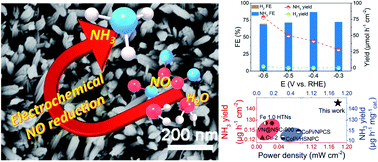Coupling denitrification and ammonia synthesis via selective electrochemical reduction of nitric oxide over Fe2O3 nanorods†
Abstract
Direct electrochemical conversion of nitric oxide (NO) into ammonia (NH3) holds great promise for high value-added utilization of industrial gaseous waste and simultaneously mitigating the human-caused imbalance of the global nitrogen cycle. Here, Fe2O3 nanorods are proposed as a superb electrocatalyst for the NO reduction reaction to produce NH3 under ambient conditions. The catalyst achieves a large NH3 yield of 78.02 μmol h−1 cm−2 with a fairly high faradaic efficiency of 86.73% in neutral media. Using such a catalyst as the cathodic material, a Zn–NO battery was assembled as an NH3-producing device with excellent NO conversion efficiency, capable of delivering a power density of 1.18 mW cm−2 and an NH3 yield of 145.28 μg h−1 mgcat.−1. Density functional theory calculations suggest that NO binds to the Fe2O3 (104) surface most strongly via electronic state interaction, adopting a charge “acceptance-donation” mechanism and is significantly activated through the 2π* back-donation effect.

- This article is part of the themed collection: Energy Frontiers: Electrochemistry and Electrochemical Engineering


 Please wait while we load your content...
Please wait while we load your content...